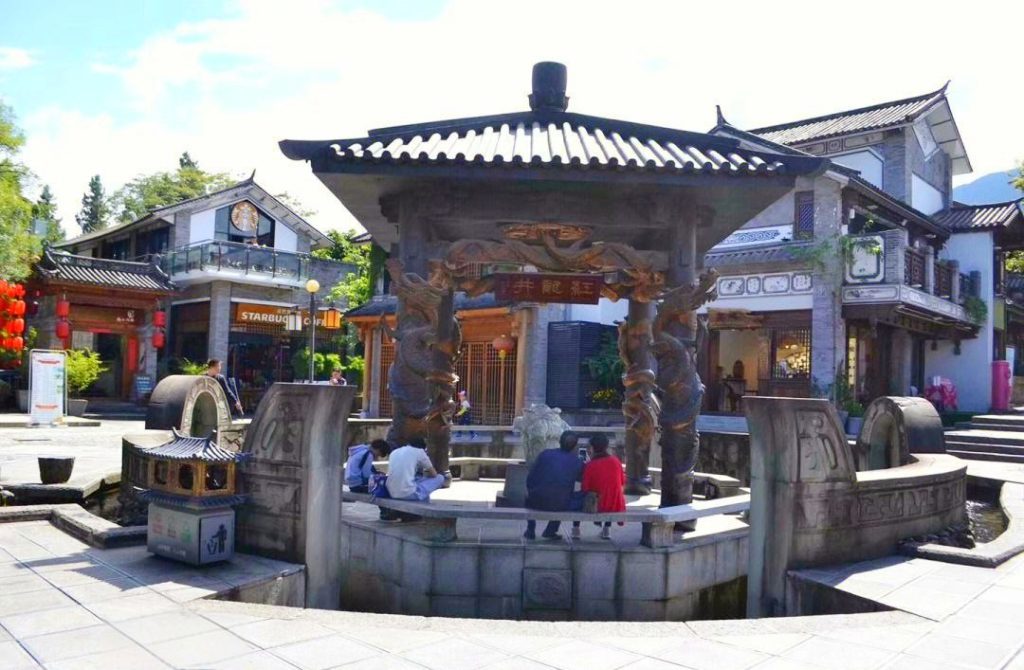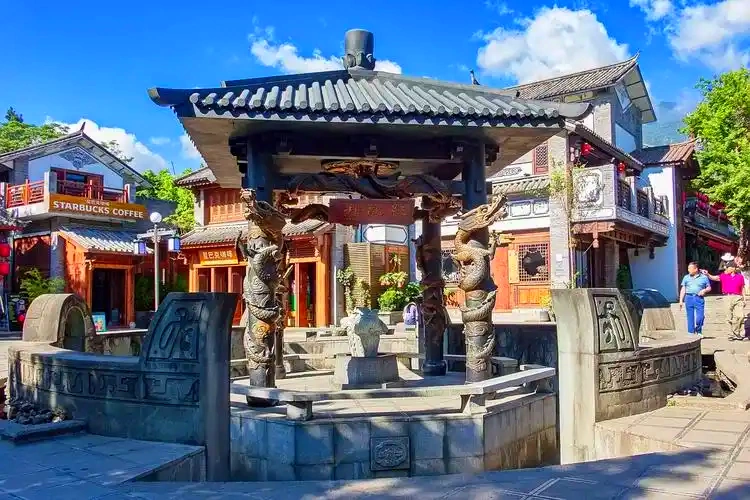
Honglongjing (Red Dragon Well) in Dali Old Town
Honglongjing (红龙井), also known as Red Dragon Well, is located in the southwest of Dali Old Town (大理古城), Yunnan Province, China. It stretches from the west city wall (西城墙) of the old town to Fuxing Road (复兴路), covering a distance of just a few hundred meters. In recent years, Honglongjing has become one of the most popular tourist spots in Dali Old Town.
The charm of Honglongjing lies in its flowing spring water, which creates a picturesque scene of “clear spring flowing over stones” (清泉石上流), particularly enchanting during the hot summer and autumn months. The area also features various scenic spots such as Yubai Cai (玉白菜, Jade Cabbage), Twelve Zodiac (十二生肖), Waterfall Platform (叠水台), and Stone Arch Bridge (石拱桥), which further enhance the area’s appeal. Additionally, the trees planted along the water channels, such as willows, osmanthus trees, cypress trees, and banyan trees, offer shade and improve the aesthetic value of the site, particularly when the osmanthus flowers bloom in autumn, filling the air with fragrance and adding to the elegance of Honglongjing.
Scenic Highlights
Water Features and Design
The Honglongjing area is part of the Dali Water Landscape Project (大理水景工程). The second phase of this project, which includes the Honglongjing Special Street (红龙井特色街区), was completed recently, spanning 408 meters and costing approximately 7.6 million RMB. The water for the area flows from the reservoir of the water landscape project, entering through the Honglongjing Gate (红龙井门洞) of the west city wall (西城墙), creating the first waterfall zone. The water cascades down through a series of small waterfalls (叠水区), producing pleasant sounds as it flows.
At Boai Road (博爱路), the water flows again through another waterfall zone, passing through the Honglongjing Hotel (红龙井酒店), where the “Jade Cabbage” (玉白菜) design, inspired by Bai ethnic folklore (白族民间传说), is integrated into the central water feature area. The water then flows through four milling stone basins (麻石磨盘型水槽) before reaching Fuxing Road (复兴路), eventually connecting to the original water feature system.
This project also improved the previous water landscape, adding seven water catchment pools (回水池) and addressing technical issues with the channels, enhancing the overall water flow effect. The stones in the water, large and small, vertical and horizontal, display the unique characteristics of Dali’s stone, while the small arch bridges and stone zodiac sculptures (石雕生肖) add artistic charm to the area. The picturesque setting embodies the harmonious relationship between humans and nature, inviting visitors to interact with the water, enjoy the scenery, and embrace the beauty of Dali Old Town.
Greenery and Aesthetic Enhancements
In addition to the flowing water, the area is adorned with lush greenery, including willow trees, osmanthus trees, banyan trees, and cypress trees, which not only provide shade but also contribute to the visual appeal of the site. When the osmanthus flowers bloom in autumn, their fragrance fills the air, making the area even more enchanting.

Cultural Significance
Honglongjing holds an important place in the revitalization of Dali Old Town, bringing back the traditional water features that once defined the town’s charm. The phrase “Street flows with water, every household has flowers” (街街流水、户户养花) was once a defining characteristic of the town, but it had gradually faded over time. In the early 2000s, the Dali Municipal Government (大理市政府) undertook a significant effort to restore these water landscapes, and today, Honglongjing is an example of the town’s successful revitalization.
With its addition, Dali Old Town now offers two distinct characteristic streets: “Foreigners’ Street” (洋人街) and Honglongjing Street. This initiative is a significant part of Dali’s urban development, contributing to the city’s charm and reinforcing its vision of becoming a “Mountain Water Garden City” (山水园林大城市) and a “Flower and Snow Garden” (风花雪月大花园). With its rich history, culture, and natural beauty, Honglongjing is a perfect blend of tradition and modernity, welcoming both local residents and visitors alike.
Attractions and Activities
-
The Jade Cabbage Fountain: Inspired by Bai folk legends, this beautifully designed water feature is one of the central highlights of the area.
-
Twelve Zodiac Sculptures: These stone carvings, representing the Chinese zodiac, are displayed along the waterway, adding to the cultural richness of the site.
-
Waterfall Platforms: The cascading water features create a serene, tranquil atmosphere, perfect for relaxation and reflection.
-
Stone Arch Bridge: A beautiful, traditional stone bridge that adds to the overall scenic charm of the area.
Practical Information
Location:
Honglongjing (红龙井) is located in the southwest of Dali Old Town (大理古城), Yunnan Province. It connects the west city wall (西城墙) to Fuxing Road (复兴路).
Opening Hours:
-
Opening Hours: Daily, from 08:00 to 17:00.
-
Recommended Visit Duration: Approximately 1–2 hours.
Admission:
-
Free Entry.
Best Time to Visit:
The best time to visit is during autumn when the osmanthus flowers bloom, filling the air with a fragrant aroma. The site is also very pleasant to visit during summer when visitors can enjoy the cool breeze and the soothing sound of the water.
Nearby Attractions:
-
Erhai Lake (洱海): Located near Dali Old Town, this is a beautiful lake that offers opportunities for boat tours, cycling, and hiking.
-
Cangshan Mountain (苍山): A scenic mountain offering hiking trails and breathtaking views of Dali and Erhai Lake.
-
Foreigner’s Street (洋人街): A popular street in Dali Old Town known for its mix of international restaurants, shops, and cafes.
How to Get There:
From Dali Railway Station:
-
By Taxi: It takes about 20 minutes by taxi from Dali Railway Station to Dali Old Town.
From Dali Airport:
-
By Taxi: The journey from Dali Airport to Dali Old Town takes about 1 hour.
Local Transport:
-
Walking: Honglongjing is located within Dali Old Town, so it is easily accessible by walking from most parts of the old town.

 7 Days GolfingTour
7 Days GolfingTour
 8 Days Group Tour
8 Days Group Tour
 8 Days Yunnan Tour
8 Days Yunnan Tour
 7 Days Shangri La Hiking
7 Days Shangri La Hiking
 11 Days Yunnan Tour
11 Days Yunnan Tour
 6 Days Yuanyang Terraces
6 Days Yuanyang Terraces
 11 Days Yunnan Tour
11 Days Yunnan Tour
 8 Days South Yunnan
8 Days South Yunnan
 7 Days Tea Tour
7 Days Tea Tour
 8 Days Muslim Tour
8 Days Muslim Tour
 12 Days Self-Driving
12 Days Self-Driving
 4 Days Haba Climbing
4 Days Haba Climbing
 Tiger Leaping Gorge
Tiger Leaping Gorge
 Stone Forest
Stone Forest
 Yunnan-Tibet
Yunnan-Tibet
 Hani Rice Terraces
Hani Rice Terraces
 Kunming
Kunming
 Lijiang
Lijiang
 Shangri-la
Shangri-la
 Dali
Dali
 XishuangBanna
XishuangBanna
 Honghe
Honghe
 Kunming
Kunming
 Lijiang
Lijiang
 Shangri-la
Shangri-la
 Yuanyang Rice Terraces
Yuanyang Rice Terraces
 Nujiang
Nujiang
 XishuangBanna
XishuangBanna
 Spring City Golf
Spring City Golf
 Snow Mountain Golf
Snow Mountain Golf
 Stone Mountain Golf
Stone Mountain Golf















